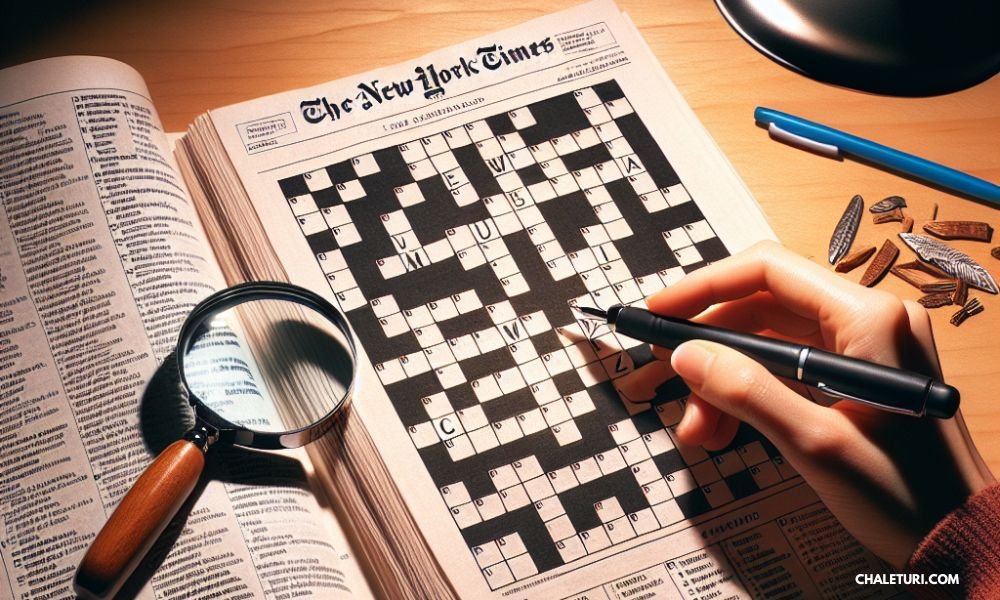Among the puzzles found on the Internet, only some can boast of the mystique of the New York Times crossword puzzle. For many years, this particular kind of intellectual pursuit has entangled the appetite of puzzle enthusiasts to the extent of mixing words and wittiness in one tray. The term latches onto NYT and conveys the psychological attachment these crosswords create in solvers worldwide. This blog post will offer a detailed view of the complex and exciting world of NYT Crosswords, their features, methods of solving, and history for both novice and experienced users.
A Glimpse into the NYT Crossword’s History
In a special albeit bleak context of World War II, when the public was looking for ways to spend their leisure, including reading, the New York Times published its first crossword in 1942. This innocent-seeming pastime quickly morphed into a pervading culture, always seeking to raise the bar and create something new within the clique in a broader sense. Beginning with mild roots, the New York Times Crossword has ascended to such a rank that, along with amusing the readers, it has also found the place of its prestige in the genre of word games and has become practically the first of its kind.
The NYT Crossword has not only amused the enthusiasts but also has systematically instructed them. The anticipation has not been confined to single puzzles, though, as, apart from its entertainment factor, its readership has developed a subculture where new puzzles are obsessively sought. The first-generation estimates of crossword editors were relatively high, and the puzzle has continued to be known for having somewhat fresh and creative ideas since then.
The present-day NYT Crossword even owes some of its current respect to the history of the Board, which has progressed from colorless squares and black filling to more dynamic grids with clues that correspond to the subject currently in demand. This progressive change stands out as an example of how relevant the puzzle is amidst fast trends.
The Irresistible Appeal of the NYT Crossword
Why have so many obsessive people tried to reverse-engineer the NYT Crossword? First and foremost, it presents an intellectual difficulty that very few other puzzles can come close to. Almost all solvers admit a particular “sickness” in each element; their obsession is that there is an inherent reason for each word in the clue and its answer. The impact of being a puzzle, often considered a cultural masterpiece, only fuels why people would want to solve it, as it acts as a workout for the brain and insight into what is currently happening worldwide.
All the credit goes to Will Shortz, who has done enormous work promoting the crossword-heavy newspaper in America. For Most Crossword Lovers, Will Shortz Is Inextricably Linked To The NYT. Ever since he took over the position of crossword editor in 1993, he has been responsible for bringing the crosswords, which consist of entirely new themes and are designed in a manner that can be solved by kids and adults too. Indeed, during his leadership in an American paper such as The New York Times, one of the most significant developments in the crossword puzzle took place, turning into a sociable activity regardless of people’s location.
The beauty of the NYT Crossword goes beyond personal pleasure-inducing fury. It has also become a bonding activity, with families and friends frequently coming together to complete the puzzles. In this shared activity, they seek the rewards of completing the grid individually and the pleasure of working and thinking together to solve a common problem.
The Enigma of “Latches Onto NYT”
Satisfaction comes to many puzzle lovers when they lay their hands on the NYT Crossword in a parallel way, gaining access to a closed group of authors and wise individuals. The expression “latches onto NYT” best defines the hunger with which solvers approach these puzzles intending to get behind every grid. Such close ties are nourished by a perfect mix of jokes, puns, and intertextuality.
Images from Jeffrey crossword puzzles NYT has won word fame for quite in this regard asos crosswords solving requires non-literal thinking on puzzles. Such play of words is often found in the constitutional insanity of the movement away from the point of the puzzle. This is why most fans are almost addicted to the games, as each day, they come back for more, even after more than a hundred years of its creation.
What makes the audience want to continue working on the Crossword is its intricacy now and its alternation of pleasant and pleasing surprises. Every puzzle conceals a story one engages with the creator’s intellect, wherein the writer’s motives are inspired with language at play. This exciting exchange of words and ideas guarantees that the NYT Crossword attracts and retains every solver, irrespective of their proficiency and expertise.
Mastering the Art of Solving the NYT Crossword
The beginners in the profession of the NYT Crosswords may shudder at the very thought of their future steps. Of course, there are ways out of the labyrinth which even the most novice of the splayed players may be able to seek out. First, make a habit of learning a few more of the usual questions and correct answers for a while since the NYT changes along with a certain number of features and word-play styles, which are pretty limited, etc. The solution to NYT Crosswords or NYT puzzles of sudoku is also better sought in Facebook NYT Crosswords groups. People publish photos of puzzles and techniques for solving them; sometimes, one wants to ask questions about how to do certain puzzles.
If the problem is so challenging that you find yourself exhausted from solving it completely, step away, do something else, or, if necessary, go to a different problem altogether. Then, put some work into the easiest or new words and phrases you do not know, and afterward, fill the grid using more advanced ones. Look at the caption and a few of the illustrations in the grid, not merely the clues of the crossword puzzle. They are often related to the puzzle’s subject and thus help solve some difficult clues.
A lot of practice, patience, and persistence are required to Crack the NYT Crossword. It is easier said than accomplished, and most original puzzles develop the skill in every individual progressively. It is also essential to remember that any puzzle solver started out as a novice and that through dedication, a person can quite easily navigate the puzzle games of the NYT Crossword.
The NYT Crossword Community and Culture
The NYT Crossword may be a game, but it is not only that; it is a community of people interested in playing around with words and challenges. The atmosphere is very encouraging and drives the need to connect with other solvers, who regularly talk and argue over the clues, themes, and methods of solving. This community has also found a voice through various social websites and forums, enabling members to post their impressions and hear others’ opinions.
The NYT Crossword is very appreciated by the community. However, the scope of the chessboard transcends even to the circles of the New York Times’ readers. The puzzle has inspired many publications, television shows, and films, fascinating the audience and demonstrating its place within culture. The breadth of this page illustrates how cultural phenomena the crossword presents relief, which is not only entertaining but also fills the core of the culture.
NYT Crossword is overtly a satirical and non-judgemental space where anyone who can solve en sterile harbors a love of crosswords. Its striking that people are still connected to the crossword puzzle well into the computer age where everything is available in a brief.
Embracing Technology in the NYT Crossword Experience
Thus, in the course of developments that can be termed as the age of digital technology, escalation of the NYT Crossword has taken place and gobbled out those puzzle sufferers from diverse dwellings via the recipes of technology use. It has become an online and mobile puzzle which has never been straightforward and easier than this time round where solvers solve the NYT Crossword anywhere and at any time.
New design changes, such as new features, have been devised to ensure the solving experience is further explored. A few additional self-service support features involve assisting clients with interactivity with the grid in other ways, such as by providing clues or measuring their time. Such developments contributed considerably to the popularity of the NYT Crossword among the new audience, which, due to the progress of technology, has become even more active and oriented toward interaction rather than classic simple crossword solving.
The incorporation of technology has altered the basic way of approaching the NYT Crossword, as in many cases the construction of the heart and soul cannot be beaten. The enjoyment and satisfaction that accompanies solving a well-crafted grid remains with every solver who has contributed to the creation of the NYT Crossword for many years, despite the support of changing technologies.
Tips for New Solvers Embarking on Their Crossword Journey
Newcomers to NYT Crosswords may find it helpful to tackle more straightforward puzzles first as these would build them up for more advanced grids and boost their confidence in solving them. There has been stratification in the difficulty levels which includes beginner early-week puzzles to even the best solvers late-week ones.
Getting into a solving rhythm is an integral part of being successful. Stick to a certain time to solve or work in short bursts if that is more effective in creating a habit of dabbling with puzzles every day for a period of time. Practice makes perfect, and over a period of time, one will increase one’s skill level, especially in speed and accuracy.
Lastly, do not forget that the NYT Crossword is not the end but a means of improving one’s vocabulary, knowledge of various aspects of language, and linguistic structures. Every grid is a challenge. Treat every grid as an exciting new prospect to learn and solve, and feel free to interact with the crossword world and its associated help to improve your skills.
The Future of the NYT Crossword
To enhance competitiveness, the NYT Crossword Industry regularly enhances itself with the knowledge of new technologies and developments. With additional advancements such as artificial intelligence and machine learning, solving can be much more fun and creative.
Even so, the NYT Crossword has incorporated some new fads and designs and elements which the solvers find appealing. Readers who wish to find relief and enjoyment in the traditional manner of span crossword are likely to be impressed with the hybrid view of tradition and brand new expectations offered by the NYT Crossword.
The NYT Crossword will be relevant for ages, and its perimeter is an illusion. Eager of new releases, during which readers and users need to get out of the box, as in there will be no conventional crossword, ensuring this iconic leisure activity retains its place in the cultural landscape.
Reflecting on the Timeless Appeal of “Latches Onto NYT”
The phrase ‘latches onto nytimes.com’ embodies how and why New York Times Crosswords resonate through the solver’s heart. This is also important because the connection of the individuals with the puzzle has a purpose – it is to amuse, teach, and motivate people of all ages. In case you are a beginner who wants to step into the world of crosswords or in search of even more crossword possibilities as an enthusiastic veteran, the New York Times Crossword has these worlds and more to offer…
All newcomers, and veteran solvers, are urged to actively participate in solving the remaining crosswords of the same newspaper, The New York Times. Take the brainteaser; interact with the community as actively as you can and relish the experience of getting attached to classic puzzle games. And don’t forget, for every puzzle that you solve, you get an inch closer to being a puzzle master. Good luck!




